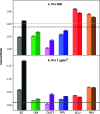National Cohort Study of Long-Term Exposure to PM2.5 Components and Mortality in Medicare American Older Adults
- PMID: 37074132
- PMCID: PMC10157884
- DOI: 10.1021/acs.est.2c07064
National Cohort Study of Long-Term Exposure to PM2.5 Components and Mortality in Medicare American Older Adults
Abstract
There is increasing evidence linking long-term fine particulate matter (PM2.5) exposure to negative health effects. However, the relative influence of each component of PM2.5 on health risk is poorly understood. In a cohort study in the contiguous United States between 2000 and 2017, we examined the effect of long-term exposure to PM2.5 main components and all-cause mortality in older adults who had to be at least 65 years old and enrolled in Medicare. We estimated the yearly mean concentrations of six key PM2.5 compounds, including black carbon (BC), organic matter (OM), soil dust (DUST), nitrate (NO3-), sulfate (SO42-), and ammonium (NH4+), using two independently sourced well-validated prediction models. We applied Cox proportional hazard models to evaluate the hazard ratios for mortality and penalized splines for assessing potential nonlinear concentration-response associations. Results suggested that increased exposure to PM2.5 mass and its six main constituents were significantly linked to elevated all-cause mortality. All components showed linear concentration-response relationships in the low exposure concentration ranges. Our research indicates that long-term exposure to PM2.5 mass and its essential compounds are strongly connected to increased mortality risk. Reductions of fossil fuel burning may yield significant air quality and public health benefit.
Keywords: PM2.5 components; air pollution; all-cause mortality; survival analysis.
Conflict of interest statement
The authors declare no competing financial interest.
Figures



References
-
- Shi L.; Steenland K.; Li H.; Liu P.; Zhang Y.; Lyles R. H.; Requia W. J.; Ilango S. D.; Chang H. H.; Wingo T.; Weber R. J.; Schwartz J. A national cohort study (2000-2018) of long-term air pollution exposure and incident dementia in older adults in the United States. Nat. Commun. 2021, 12, 6754.10.1038/s41467-021-27049-2. - DOI - PMC - PubMed
-
- McGuinn L. A.; Schneider A.; McGarrah R. W.; Ward-Caviness C.; Neas L. M.; Di Q.; Schwartz J.; Hauser E. R.; Kraus W. E.; Cascio W. E.; Diaz-Sanchez D.; Devlin R. B. Association of long-term PM2.5 exposure with traditional and novel lipid measures related to cardiovascular disease risk. Environ. Int. 2019, 122, 193–200. 10.1016/j.envint.2018.11.001. - DOI - PMC - PubMed
Publication types
MeSH terms
Substances
Grants and funding
LinkOut - more resources
Full Text Sources
Medical

